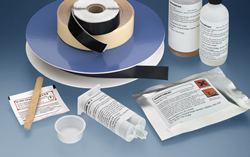A Sticky Situation: Selecting the Right Adhesive
 TE Connectivity manufactures adhesives and sealants to accommodate a wide range of applications, materials, and environmental conditions. The following is a brief overview on how to select, prepare, and install the correct adhesive to the surface of your product. It is not intended to be a definitive guide to adhesive selection; visit TE online to view the full guide.
TE Connectivity manufactures adhesives and sealants to accommodate a wide range of applications, materials, and environmental conditions. The following is a brief overview on how to select, prepare, and install the correct adhesive to the surface of your product. It is not intended to be a definitive guide to adhesive selection; visit TE online to view the full guide.
TE’s Raychem adhesives include both thermosets and thermoplastics. Thermosets are curable two-part epoxies or cross-linked elastomers. Thermoplastics are hot-melt adhesives that flow when heated and set when cooled. They reflow when reheated to simplify component repair. TE also manufactures Raychem products that include a thermoplastic adhesive or a mastic-type sealant for water holdout applications. The sealants adhere to non-oily substrates and can be removed where reentry is necessary.
Adhesive Selection
Many applications require special considerations.
- Space equipment, vehicles, and other applications require an environmental seal that is flexible, watertight, low outgassing, and permanent.
- Wire harness systems requiring resistance to the effects of nuclear, biological, and chemical agent exposure and decontamination should use material that has been hardened to withstand the damaging effect of NBC contamination and decontamination washdowns.
- For molded parts, a general purpose, hot-melt thermoplastic adhesive supplied in tape form for easy application to cable substrates supplies a tough yet flexible adhesive. It is suitable for bonding polyolefins, vinyls, and neoprenes, and metals such as steel and aluminum.
- Marine applications where salt water is a threat require an adhesive that is very user-friendly, and exhibits excellent flow when heated under normal installation conditions. It is not recommended where aggressive solvents may be present or for terminations under in-service flexural stress at temperatures above 40°C.
- Adhesive tapes are well suited for military ground vehicle electrical harness sealing, due to their temperature- and fluid-resistance characteristics. Raychem-brand S1124 is a flexible adhesive based on elastomeric polymers, which provides good bonds to metals such as steel and aluminum when the bond line is heated to 150°C.
- Use a hot-melt thermoplastic pre-coat adhesive with heavy-duty boots and cable entry seals. It is suitable for bonding to various cable jacket substrates, including polyethylene, PVC, polychloroprene, and metals such as steel and aluminum.
General Installation Procedures
The preparation of the substrate depends on the part to be bonded. Two preparation procedures are identified: Applications to plated metals and adapters; applications to polymer molded parts, cable jackets, and tubing materials.
Bonding between molded parts, plated metals, and adapters
To ensure the best possible bond between a molded part and plated materials and adapters, degrease the end of the molded part that will recover onto the plated metal or adaptor with isopropyl alcohol or isopropanol (IPA) impregnated tissue wipe. NEVER abrade plated metals and adapters.
Where preheating of the plated metal or adapter is necessary for large and high-heat-sink terminations, care must be taken to ensure the connector insulation and primary wire insulation are not damaged. Direct the heat to the metal area and avoid all other areas.
Bonding between molded parts, cable jackets, and tubing materials
To ensure the best possible bond between the molded part, cable jacket, or tubing, degrease the cable jacket in the area where the molded part will recover onto the cable using isopropyl alcohol, approximately 30mm in length. Abrade the cable jacket thoroughly in the same area with 100 grit emery cloth. The whole surface of the cable jacket should be abraded, removing any print on the cable jacket. Remove loose particles from the abraded area using a dry tissue. DO NOT use a solvent wipe.
Ensure sufficient cable jacket surface has been abraded to incorporate the strip length required. Degrease the inner area of the molded part at each end thoroughly (approximately 30mm) using isopropyl alcohol. Thoroughly abrade the inner area of the molded part at each end (approximately 30mm) with 100 grit emery cloth. Remove loose particles from the abraded area using a dry tissue. DO NOT use a solvent wipe.
Health and Safety Concerns
The installation should be carried out in a well-ventilated area. Always wear heat-resistant safety gloves when handling hot plastics and adhesives. The use of suitable protective gloves and barrier cream is recommended when using solvents.
Avoid prolonged repeated skin contact with solvents and always wash hands after using solvents. Care should be taken to wear safety glasses when using and handling chemical solvents. If eyes do become contaminated, flush with water, and obtain medical assistance immediately.
- FCI’s RotaConnect Board-to-Board Connector - April 15, 2013
- Molex’s Brad Ultra-Lock (M12) EX Connection System for Explosive and Hazardous Areas - September 17, 2012
- J-Tech Expands Harsh Environment Ethernet and USB Connector Offering - September 17, 2012



